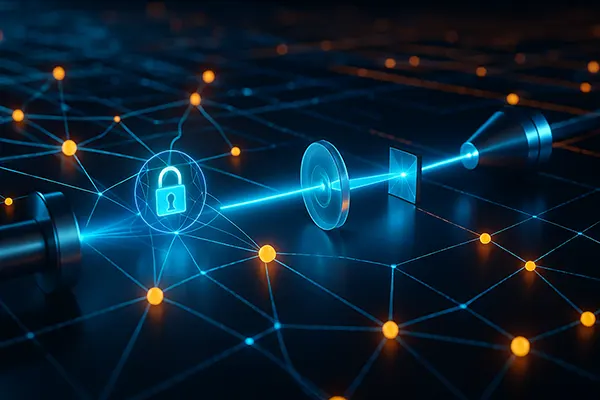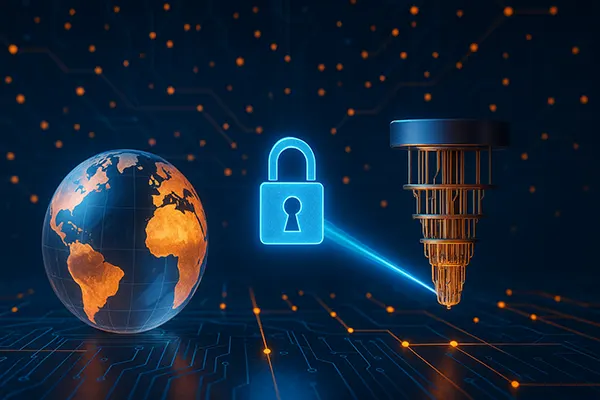
Quantum Communication: Encryption Beyond Classical Channels
Quantum communication has emerged as one of the most promising technologies for securing information in an era where traditional cryptographic methods are becoming increasingly vulnerable to the power of quantum computing. Unlike classical systems that rely solely on mathematical complexity, quantum communication introduces physical security rooted in the laws of quantum mechanics. This makes it a crucial field for governments, financial institutions, and industries where absolute confidentiality is essential.
Quantum Key Distribution as a Core Technology
At the heart of quantum communication lies Quantum Key Distribution (QKD), a process that allows two parties to create and share a cryptographic key with guaranteed security. The key advantage of QKD is that any attempt to intercept the transmission inevitably disturbs the quantum states involved, making eavesdropping detectable. This property is impossible to replicate in classical communication systems.
QKD is implemented using photons transmitted through optical fibres or free-space links. These photons carry information in quantum states such as polarisation, which can be measured but not copied without altering the state. This ensures that the integrity of the key remains intact. Protocols like BB84, developed in the 1980s, continue to serve as the foundation for modern implementations.
Over the last decade, QKD has moved from experimental research into practical deployments. Companies in Europe and Asia have already established operational networks where financial data and government communications are transmitted using QKD-secured systems.
Challenges and Current Developments
Despite its promise, QKD is not without limitations. The distance over which photons can travel without degradation remains a challenge, especially in fibre-based systems where losses increase significantly beyond 200 km. To overcome this, researchers are developing quantum repeaters that can extend secure communication across continents.
Cost and scalability also remain pressing issues. Deploying quantum-secure networks requires specialised equipment, such as single-photon detectors and entangled photon sources, which are currently expensive and technologically demanding. However, rapid advancements in miniaturisation and integration with existing telecom infrastructure are reducing these barriers.
Another frontier in development is satellite-based quantum communication. China’s Micius satellite, launched in 2016, demonstrated intercontinental QKD, proving that global quantum networks are achievable. The European Union is also heavily investing in quantum infrastructure projects as part of its Quantum Flagship programme.
Building Quantum Networks
Beyond individual QKD links, the vision of quantum communication involves creating large-scale quantum networks. These networks function similarly to the internet but use entanglement and quantum states instead of classical signals. Their main purpose is to enable ultra-secure communication and, in the future, distributed quantum computing.
Quantum networks require the establishment of trusted nodes, where keys can be securely relayed and managed. In practice, this could allow cities, countries, and even continents to be connected via quantum-secure backbones. Financial hubs such as Zurich, London, and Tokyo are already experimenting with testbeds for such infrastructure.
The development of quantum networks also intersects with post-quantum cryptography. While algorithmic solutions focus on designing mathematical problems resistant to quantum attacks, quantum networks provide physical-level protection, offering a complementary approach to global cybersecurity strategies.
Practical Applications in Key Sectors
Governments are among the first adopters of quantum communication, particularly in areas related to national security and intelligence. Secure diplomatic channels and military communications can benefit from QKD’s tamper-evident properties. The financial sector is another critical area, where banks and stock exchanges are increasingly concerned about the possibility of quantum attacks on current encryption standards.
Healthcare is also exploring quantum-secure communication for protecting patient records and sensitive research data. Similarly, multinational corporations handling intellectual property are considering QKD-based solutions to ensure trade secrets remain protected against industrial espionage.
Several pilot projects, particularly in China, South Korea, and across the European Union, already demonstrate real-world applications. These examples show that quantum-secure infrastructure is not a distant concept but a rapidly growing field with immediate benefits for sectors requiring the highest level of security.

The Future of Secure Data Transmission
Looking ahead, quantum communication is expected to evolve from niche projects into mainstream adoption over the next decade. Advances in quantum repeaters, integrated photonics, and hybrid systems combining classical and quantum technologies will play a decisive role in shaping this transition.
Standardisation efforts are underway, with organisations such as ETSI and ITU developing frameworks for interoperability between different quantum communication systems. These efforts aim to ensure that quantum-secure networks can be seamlessly connected across borders and industries.
By 2035, experts anticipate that quantum communication will become a critical part of global cybersecurity strategies. Rather than replacing classical systems outright, it will function as an additional layer of security, especially for high-value information where breaches could have catastrophic consequences.
Global Initiatives and Strategic Importance
The strategic significance of quantum communication cannot be overstated. Nations are competing to establish leadership in this domain, recognising its potential impact on military defence, economic stability, and technological sovereignty. China remains a pioneer, but Europe and the United States are rapidly increasing their investments.
In the commercial sector, telecommunications providers are exploring ways to integrate QKD into their fibre optic infrastructure. This would make quantum-secure services available to a wider range of customers, from large corporations to private consumers concerned with digital privacy.
Ultimately, quantum communication represents a paradigm shift. By securing data at the physical level, it offers a path towards truly unbreakable encryption, reinforcing trust in the digital systems upon which modern society increasingly depends.





